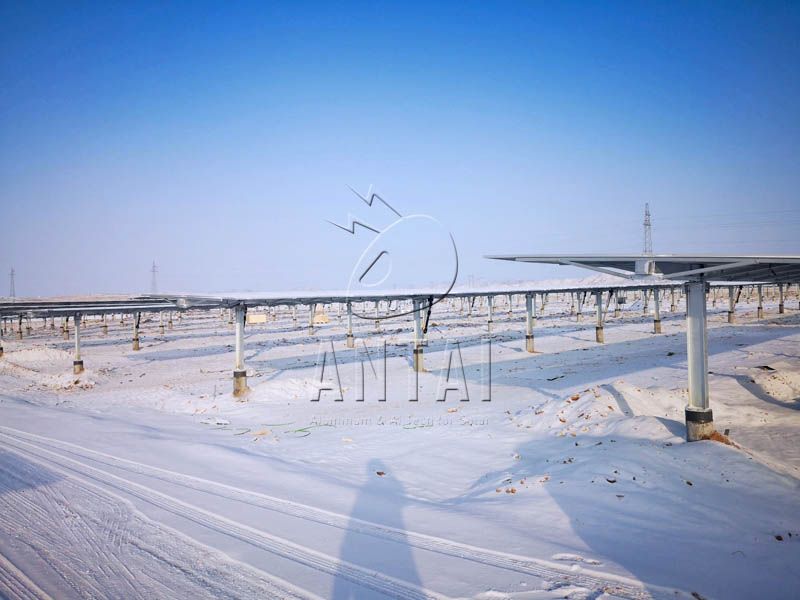Single Point vs. Multi-Point Slew Drives in Solar Trackers: An In-Depth Comparison
November 04, 2025
In the evolving landscape of solar energy, the efficiency and reliability of solar trackers are paramount to maximizing energy yield and ensuring a high return on investment. The drive system, the veritable heart of a solar tracker, plays a pivotal role in its performance. When it comes to selecting the right technology, the choice between a single-point slew and a synchronous multi-point slew drive is not a matter of one being definitively "better," but rather which is the optimal solution for a specific project's unique landscape, layout, and environmental conditions. This article provides a comprehensive comparison of single-point slew and synchronous multi-point slew tracker systems, exemplified by Antaisolar’s TAI-Simple and TAI-Universal models, to guide EPCs, developers, and investors in making an informed engineering decision.


Single Point Slew Drive Trackers
A single point slew drive tracker, as its name suggests, is powered by a single motor that drives an entire row of solar modules. This design offers a streamlined and cost-effective solution, making it an attractive option for standard-length arrays in moderate environments with uniform terrain. The simplicity of the single point slew drive mechanism translates to lower initial capital expenditure (CAPEX) and a more straightforward installation process. Antaisolar's TAI-Simple is a prime example of a single point slew drive tracker that leverages this technology to provide a reliable and efficient solution for a wide range of solar projects.
Synchronous Multi-Point Slew Drive Trackers
In contrast, synchronous multi-point slew drive trackers are equipped with multiple, synchronized motors that distribute the load along the entire length of the tracker row. This innovative design provides enhanced stability, superior load balance, and greater design flexibility, particularly for larger and more complex solar installations. The distributed nature of the drive system makes synchronous multi-point slew trackers exceptionally well-suited for challenging climates and uneven landscapes. Antaisolar’s TAI-Universal exemplifies the advantages of this technology, offering a robust and adaptable solution for even the most demanding solar projects.


Scenario-Based Comparison: Matching the Drive to the Project
To better understand the practical implications of choosing between single-point slew and synchronous multi-point slew drives, let's explore a few real-world scenarios:
1. Shorter Rows & Cost-Sensitive Projects
For projects with standard-length tracker rows (typically up to 90 meters) where wind loads are moderate and the terrain is relatively uniform, a single point slew drive tracker like the TAI-Simple is the ideal fit. The streamlined structure of a single-point slew system minimizes the CAPEX per megawatt and simplifies the construction process, leading to significant cost savings. The lower upfront cost, coupled with faster and easier installation, makes single-point slew trackers a proven and reliable choice for mainstream solar farm configurations.
2. Long Rows & Maximum Land Utilization
When the goal is to maximize land utilization with extended tracker rows, such as in 2P (two-in-portrait) configurations up to 90 meters, a synchronous multi-point slew drive tracker like the TAI-Universal offers a distinct advantage. The distributed drive mechanism prevents the accumulation of stress on the torque tube and ensures uniform motion along the entire row. This allows for the use of fewer foundations and motors per megawatt, enhancing land-use efficiency and potentially lowering the overall Balance of System (BOS) costs. The ability to support longer rows translates to a higher energy yield per unit of land, making synchronous multi-point slew drives a compelling option for large-scale solar projects.
3. High Wind & Harsh Weather Environments
In regions prone to high winds and other harsh weather conditions, the stability and resilience of the solar tracker are of utmost importance. Multi-slew drive trackers, such as the TAI-Universal, excel in these demanding environments. By distributing the structural loads across multiple points, this system offers superior wind resistance and effectively mitigates aeroelastic effects like galloping. The exceptional wind stability of synchronous multi-point slew trackers has been proven in demanding projects, such as the Binzhou project, which successfully withstood Level-11 typhoons. Furthermore, these systems have been validated through rigorous CPP wind tunnel tests, ensuring their long-term reliability and operational safety in extreme climates.
4. Complex & Uneven Terrain
Solar projects are increasingly being developed on sites with complex and uneven terrain. In such cases, the flexibility of the tracker system is crucial to minimize the need for extensive and costly civil works. Multi-slew drive trackers, with their inherent design flexibility, are the superior choice for these challenging landscapes. The TAI-Universal, for instance, can accommodate north-south terrain slopes of up to 20%, allowing for a more adaptable and cost-effective layout. This flexibility simplifies the installation process and reduces the overall civil engineering costs, making solar development viable on a wider range of sites.


Conclusion
The decision between a single-point slew and a synchronous multi-point slew drive system ultimately hinges on a project's specific financial goals, site conditions, and environmental factors. There is no one-size-fits-all answer. Antaisolar, a leading provider of solar mounting systems, recognizes this and offers both single-point slew and synchronous multi-point slew tracker solutions to ensure that every client receives a custom-engineered system that maximizes performance, reliability, and ROI.
end
